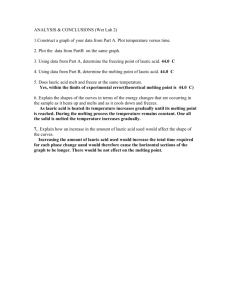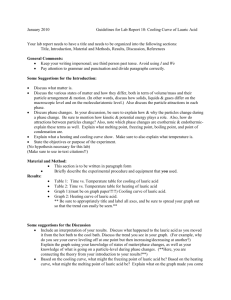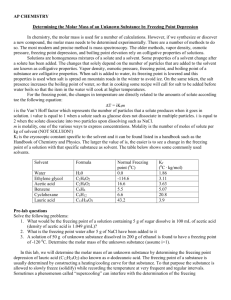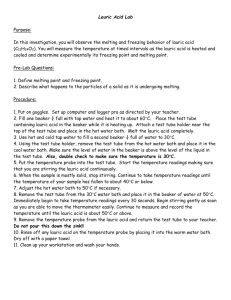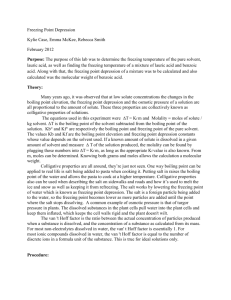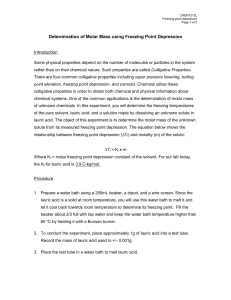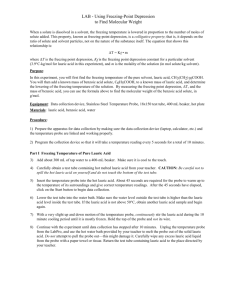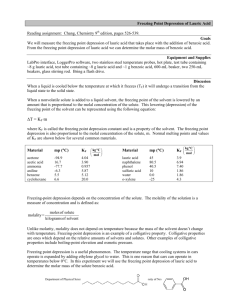Using Freezing-Point Depression to Find Molecular Weight
advertisement
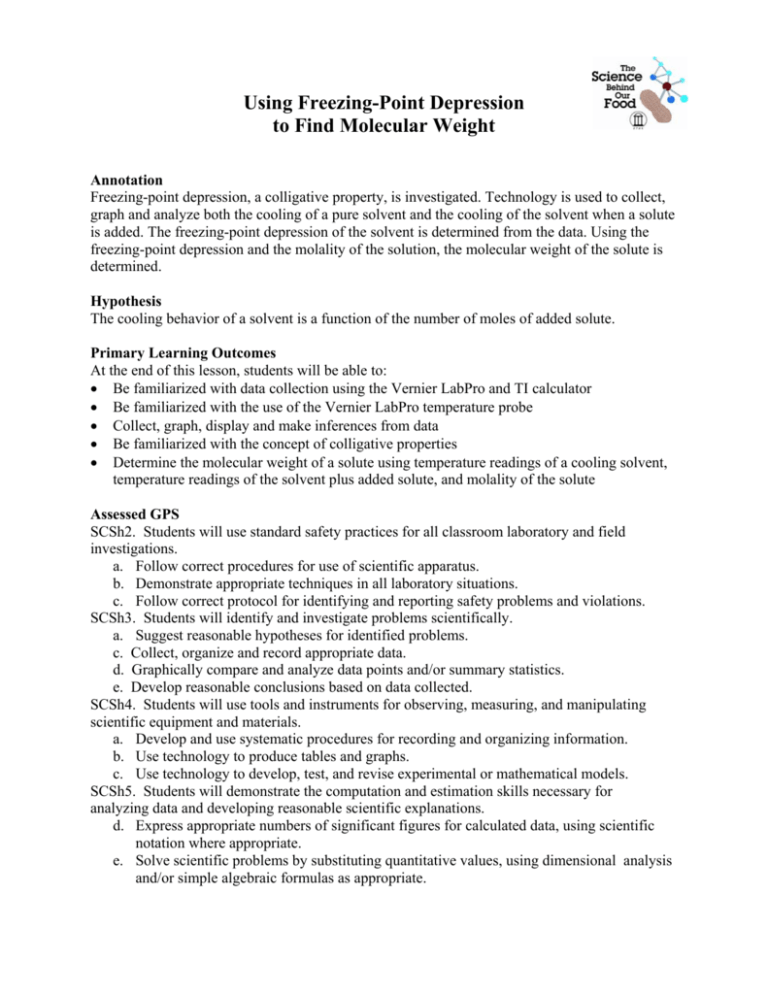
Using Freezing-Point Depression to Find Molecular Weight Annotation Freezing-point depression, a colligative property, is investigated. Technology is used to collect, graph and analyze both the cooling of a pure solvent and the cooling of the solvent when a solute is added. The freezing-point depression of the solvent is determined from the data. Using the freezing-point depression and the molality of the solution, the molecular weight of the solute is determined. Hypothesis The cooling behavior of a solvent is a function of the number of moles of added solute. Primary Learning Outcomes At the end of this lesson, students will be able to: • Be familiarized with data collection using the Vernier LabPro and TI calculator • Be familiarized with the use of the Vernier LabPro temperature probe • Collect, graph, display and make inferences from data • Be familiarized with the concept of colligative properties • Determine the molecular weight of a solute using temperature readings of a cooling solvent, temperature readings of the solvent plus added solute, and molality of the solute Assessed GPS SCSh2. Students will use standard safety practices for all classroom laboratory and field investigations. a. Follow correct procedures for use of scientific apparatus. b. Demonstrate appropriate techniques in all laboratory situations. c. Follow correct protocol for identifying and reporting safety problems and violations. SCSh3. Students will identify and investigate problems scientifically. a. Suggest reasonable hypotheses for identified problems. c. Collect, organize and record appropriate data. d. Graphically compare and analyze data points and/or summary statistics. e. Develop reasonable conclusions based on data collected. SCSh4. Students will use tools and instruments for observing, measuring, and manipulating scientific equipment and materials. a. Develop and use systematic procedures for recording and organizing information. b. Use technology to produce tables and graphs. c. Use technology to develop, test, and revise experimental or mathematical models. SCSh5. Students will demonstrate the computation and estimation skills necessary for analyzing data and developing reasonable scientific explanations. d. Express appropriate numbers of significant figures for calculated data, using scientific notation where appropriate. e. Solve scientific problems by substituting quantitative values, using dimensional analysis and/or simple algebraic formulas as appropriate. SC2. Students will relate how the Law of Conservation of Matter is used to determine chemical composition in compounds and chemical reactions. c. Apply concepts of the mole and Avogadro’s number to conceptualize and calculate • Empirical/molecular formulas • Mass, moles and molecules relationships SC7. Students will characterize the properties that describe solutions and the nature of acids and bases. a. Explain the process of dissolving in terms of solute/solvent interactions: • Express concentrations as molarities • Relate molality to colligative properties Duration 90 minutes Materials and Equipment 400-mL beaker 18 X 150-mL test tube lauric acid benzoic acid thermometer water ring stand utility clamp Technology Connection Vernier LabPro interface TI Graphing Calculator Vernier DataMate program Vernier Temperature Probe Procedures Step 1: Introduction, 20 minutes Lead a review of physical properties: Physical properties can be divided into two categories. Extensive properties depend on the size of the sample. Intensive properties are characteristic properties of the substance; they do not depend on the size of the sample being studied. A third category is a subset of the intensive properties of a system. This third category, known as colligative properties (Sections 18.3 & 18.4 – Chemistry text), can only be applied to solutions. By definition, one of the properties of a solution is a colligative property if it depends only on the ratio of the number of particles of solute and solvent in the solution, not the identity of the solute. Elicit examples of each property: for example, mass and volume are extensive properties, density and concentration are intensive properties, osmotic pressure, boiling-point elevation and freezing-point depression are colligative properties. Colligative properties are observed in experiments where the ratio of solute and solvent is known and/or unknown. Review the calculation of the molality (not molarity) of a solution: Molality = (mol solute)/(1000 g solvent) Review the equation for the freezing-point depression, ∆t = Kf•m, where Kf is the molal freezing-point depression constant of the solvent (given) and m is the molality of the solution. Irrespective of the method of temperature observation (e.g., thermometer, temperature probe attached to electronic data collection device, etc.), graphs of temperature vs. time for a cooling solution will have a characteristic appearance: Cooling Solution Temperature Time Draw this graph on the board for students to record. Using their calculators and the Vernier DATAMATE program, students will then select the region shown above as bounded by the red bars and take the mean of the range of values spanning this interval. This mean value is to be interpreted as the freezing temperature of the solution. Students will calculate the molecular weight of benzoic acid. The freezing temperature of the solute, lauric acid, will be determined as described above. In this experiment, the lauric acid-benzoic acid solution will exhibit a more gradual drop in temperature. Students will in this case take the temperature at which the solution first begins to freeze. Cooling Solution Temperature Time Students will calculate the freezing-point depression as the ∆t between the freezing temperature of pure lauric acid and that of the lauric acid-benzoic acid solution. The freezing-point depression constant (Kf) for lauric acid is given (3.9˚C•kg/mol). The molality is determined by the freezing-point depression equation given above. Given this information as well as prior knowledge about the properties of water, ask students to share and record their hypothesis regarding the following: • In a comparison between the cooling of a lauric acid solution and a lauric acid-benzoic acid solution, which of the two will have the lower freezing temperature? Show students the setup, including initialization and preparation of the probe, LabPro device, and calculator. Refer to the student activity handout for visual. Have students look over the student activity handout to anticipate the sequence of data entry and button combinations on the TI calculators. Ask if there are any questions about the procedure (5 minutes max). Step 2: Activity, 50 minutes Students will break up into groups and conduct activity “Using Freezing-Point Depression to Find Molecular Weight” as outlined in student activity handout. Recommendations/Comments: • It is recommended that 20 x 150 mm, 25 x 150 mm or 18 x 150 mm test tubes be used. • Calculations will be useful at two significant figures for the final outcome (i.e., 1.2E2 g/mol=120 g/mol as opposed to 119 g/mol=1.19E2 g/mol). • Pre-prep setups so that pre-measured and labeled lauric acid and benzoic acid samples are pre-heated on hot plates ready for use for class periods ≤50 minutes. For all class periods, pre-prep hot plates with hot water baths to save time. • Benzoic acid: moderately toxic; skin, eye, respiratory tract irritant. Step 3: Review, 20 minutes Gather students as a class and discuss results, answers to the review questions given at the end of the student handout, and any problems or questions with the procedure. Assessment Completed student worksheets will be collected and graded. Student understanding of activity components may be assessed by unit examination. Student affect and work ethic may be assessed by affect/ethic rubric. References Holmquist, D.D., Randall, J. & Volz, D. (2000). Chemistry with Calculators. pp. 1-1 – 1-T3. Vernier Software & Technology: Beaverton, Oregon. Colligative Properties (n.d.), accessed 1/15/05 from http://chemed.chem.purdue.edu/genchem/topicreview/bp/ch15/colligative.html Using Freezing-Point Depression to Find Molecular Weight When a solute is dissolved in a solvent, the freezing temperature is lowered in proportion to the number of moles of solute added. This property, known as freezing-point depression, is a colligative property; that is, it depends on the ratio of solute and solvent particles, not on the nature of the substance itself. The equation that shows this relationship is: ∆t = Kf • m where ∆t is the freezing point depression, Kf is the freezing point depression constant for a particular solvent (3.9°C-kg/mol for lauric acid in this experiment1), and m is the molality of the solution (in mol solute/kg solvent). In this experiment, you will first find the freezing temperature of the pure solvent, lauric acid, CH3(CH2)10COOH. You will then add a known mass of benzoic acid solute, C6H5COOH, to a known mass of lauric acid, and determine the lowering of the freezing temperature of the solution. In an earlier experiment, you observed the effect on the cooling behavior at the freezing point when a solute was added to a pure substance. By measuring the freezing point depression, ∆t, and the mass of benzoic acid, you can use the formula above to find the molecular weight of the benzoic acid solute, in g/mole. Figure 1 MATERIALS LabPro interface TI Graphing Calculator DataMate program Temperature Probe ring stand utility clamp goggles 1 400-mL beaker 18 X 150-mL test tube lauric acid benzoic acid thermometer water Gloves & apron “The Computer-Based Laboratory,” Journal of Chemical Education: Software, 1988, Vol. 1A, No. 2, p. 73. PROCEDURE 1. Obtain and wear goggles. 2. Plug the Temperature Probe into Channel 1 of the LabPro or CBL 2 interface. Use the link cable to connect the TI Graphing Calculator to the interface. Firmly press in the cable ends. 3. Turn on the calculator and start the DATAMATE program. Press CLEAR to reset the program. 4. Set up the calculator and interface for the Temperature Probe. a. Select SETUP from the main screen. b. If the calculator displays a Temperature Probe in CH 1, proceed directly to Step 5. If it does not, continue with this step to set up your sensor manually. c. Press ENTER to select CH 1. d. Select TEMPERATURE from the SELECT SENSOR menu. e. Select the Temperature Probe you are using (in °C) from the TEMPERATURE menu. 5. Set up the data-collection mode. a. b. c. d. e. To select MODE, press once and press ENTER . Select TIME GRAPH from the SELECT MODE menu. Select CHANGE TIME SETTINGS from the TIME GRAPH SETTINGS menu. Enter “6” as the time between samples in seconds. Enter “100” as the number of samples. The length of the data collection will be 10 minutes. f. Select OK to return to the setup screen. g. Select OK again to return to the main screen. Part I Freezing Temperature of Pure Lauric Acid 6. Add about 300 mL of tap water with a temperature between 20 and 25°C to a 400-mL beaker. Place the beaker on the base of the ring stand. 7. Use a utility clamp to obtain a test tube containing hot melted lauric acid from your teacher. Fasten the utility clamp at the top of the test tube. Caution: Be careful not to spill the hot lauric acid on yourself and do not touch the bottom of the test tube. 8. Insert the Temperature Probe into the hot lauric acid. About 30 seconds are required for the probe to warm up to the temperature of its surroundings and give correct temperature readings. During this time, fasten the utility clamp to the ring stand so the test tube is above the water bath. 9. After the 30 seconds have elapsed, select START to begin data collection. 10. Lower the test tube into the water bath. Make sure the water level outside the test tube is higher than the lauric acid level inside the test tube. If the lauric acid is not above 50°C, obtain another lauric acid sample and begin again. 11. With a very slight up and down motion of the Temperature Probe, continuously stir the lauric acid during the cooling. Hold the top of the probe and not its wire. 12. Data collection will stop after 10 minutes. Use the hot water bath provided by your teacher to melt the probe out of the solid lauric acid. Do not attempt to pull the probe out—this might damage it. Carefully wipe any excess lauric acid liquid from the probe with a paper towel or tissue. Return the test tube containing lauric acid to the place directed by your teacher. 13. To determine the freezing temperature of pure lauric acid, you need to determine the temperature in the portion of the graph with nearly constant temperature. Examine the data points along this portion of the graph. As you move the cursor right or left, the time (X) and temperature (Y) values of each data point are displayed below the graph. Determine this temperature, either by visually approximating the value or by taking the mathematical average of the temperatures in this plateau. Record the freezing temperature of pure lauric acid in your data table (round to the nearest 0.1°C). 14. To determine the freezing temperature of pure lauric acid, you need to analyze the portion of the graph with nearly constant temperature. To do this: a. Press ENTER to return to the main screen, then select ANALYZE. b. Select STATISTICS from the ANALYZE OPTIONS menu. c. Use to move the cursor to the beginning of the flat section of the curve. Press ENTER to select the left boundary of the flat section. d. Move the cursor to the end of the flat section of the graph, and press ENTER to select the right boundary of the flat section. The program will now calculate and display the statistics for the data between the two boundaries. e. Record the MEAN value as the freezing temperature in your data table (round to the nearest 0.1°C). f. Press ENTER to return to the ANALYZE OPTIONS menu, then select RETURN TO MAIN SCREEN. 15. Store the data from the first run so that it can be used later. To do this: a. Select TOOLS from the main screen. b. Select STORE LATEST RUN from the TOOLS MENU. Part II Freezing Temperature of a Solution of Benzoic Acid and Lauric Acid 16. Choose START to begin data collection. 17. Obtain a test tube containing a melted solution with ~1 g of benzoic acid dissolved in ~8 g of lauric acid. Record the precise masses of benzoic acid and lauric acid as indicated on the label of the test tube. Repeat Steps 6-12 to determine the freezing point of this mixture. 18. To determine the freezing point of the benzoic acid-lauric acid solution, you need to determine the temperature at which the mixture first started to freeze. Unlike pure lauric acid, cooling a mixture of benzoic acid and lauric acid results in a slow gradual drop in temperature during the time period when freezing takes place. Examine the data points to locate the freezing point of the solution, as shown in this figure. As you move the cursor right or left on the displayed graph, the time (X) and temperature (Y) values of each data point are displayed below the graph. Record the freezing point in the Data and Calculations table (round to 0.1°C). Time 19. A good way to compare the freezing curves of the pure substance and the mixture is to view both sets of data on one graph. To do this: a. b. c. d. Press ENTER to return to the main screen. Select GRAPH from the main screen, then press ENTER . Select MORE, then select L2 AND L3 VS L1 from the MORE OPTIONS menu. Both temperature runs should now be displayed on the same graph. Each point of Part I (pure lauric acid) is plotted with a box, and each point of Part II (benzoic acid and lauric acid) is plotted with a dot. 20. Print a graph of temperature vs. time (with two curves displayed). Label each curve as pure lauric acid or benzoic acid and lauric acid. Name_______________________________________________ Student Worksheet: Using Freezing-Point Depression to Find Molecular Weight Atomic weight of C: ~12; H: ~1; O: ~16 Extensive properties depend on______________________________________________. Intensive properties do not depend on ____________________________________________________________________. Colligative properties depend on_____________________________________________. 1. Determine the difference in freezing temperatures, ∆t, between the pure lauric acid (t1) and the mixture of lauric acid and benzoic acid (t2). Use the formula, ∆t = t1 - t2. 2. Calculate molality (m), in mol/kg, using the formula, ∆t = Kf • m (Kf = 3.9°C-kg/mol for lauric acid). 3. Calculate moles of benzoic acid solute, using the answer in Step 2 (in mol/kg) and the mass (in kg) of lauric acid solvent. 4. Calculate the experimental molecular weight of benzoic acid, in g/mol. Use the original mass of benzoic acid from the Data and Calculations table, and the moles of benzoic acid you found in the previous step. 5. Determine the accepted molecular weight for benzoic acid from its formula, C6H5COOH. 6. Calculate the percent error. %error = (experimental value – accepted value) / (experimental value) X 100
